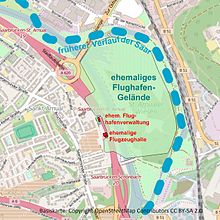Saarbrücken-St. Arnual
The Saarbrücken-St Airport. Arnual in the Sankt Arnual district of the Saarland capital of Saarbrücken was the forerunner of today 's Saarbrücken-Ensheim Airport .
history
In 1914, with the support of the military, the city of Saarbrücken had an airport built on the Saarwiesen between the locality of St. Arnual and the Saar , which at that time still curved far to the east. It served as a military airfield during the First World War.
In 1924, the existing plans for a commercial airport made progress because, after long negotiations, France had agreed to be recognized as a customs airport, which was a prerequisite for the connection to the international air transport network. Between 1924 and 1928, it was finally expanded into a commercial airport. From September 17, 1928, a trial air traffic was operated on the Paris - Saarbrücken - Frankfurt route. The airport was not officially opened and regular air traffic began in 1929. Until 1934, Luft Hansa and SGTA ( Lignes Farman ) and Air France operated a Paris - Saarbrücken - Frankfurt - Berlin line in the pool system during the summer months . In 1929 there was a connection Saarbrücken - Karlsruhe (later Mannheim) - Stuttgart - Munich operated by Luft Hansa alone, and in 1930 one to Cologne was added, which was temporarily canceled in 1932 due to insufficient subsidies.
On June 13, 1931, an aircraft on the Saarbrücken – Cologne line with the aircraft registration number D-1455 crashed over the St. Arnual artillery barracks after it caught fire immediately after take-off in Saarbrücken and the pilot wanted to turn back. All four inmates were killed.
As part of its trip to Germany , the airship LZ 127 Graf Zeppelin undertook a trip to Saarland on June 25, 1933 , during which it flew from Friedrichshafen to Saarbrücken in 4 ½ hours . In order to avoid the appearance of a “national rally” in the sense of Nazi propaganda , the Saar government commission issued a number of restrictions that also affected the music program. Regardless of this, the more than ten thousand visitors started singing the Deutschlandlied .
From 1933, Lufthansa also flew to Saarbrücken in winter. The traffic was meager; it is obvious that Saarbrücken was only included in the scheduled flight network for political reasons.
With the reorganization of the Saar area in 1935, the connection with Paris and the French participation in the regular service with Saarbrücken ceased to exist. As a result, Lufthansa operated airlines on alternating routes to the interior of Germany without a satisfactory volume of traffic. Winter traffic ceased in 1938/39. Lufthansa's standard aircraft, the Ju 52, was oversized for the low volume of traffic, so that Saarbrücken was mainly approached with small - and thus often more modern from 1934 - aircraft.
The airport was intended as a temporary solution from the outset, as the Saarwiesen were used to obtain drinking water, did not offer enough space, was at high risk of flooding and was difficult to fly to. It was not until 1936 that the construction of a new airport in Ensheim began, which was almost completed when the war broke out. Lufthansa made the last scheduled flight at the old airport on August 25, 1939. As a result, the military used it again, after the end of the war it was mainly used for sport aviation and air transport, temporarily also for scheduled services. The new airport in the Ensheim district was not put into operation until 1955, making the old one superfluous.
There is nothing left of the old airport facilities today - apart from the access road that was used as a parking lot at the time, with a remaining row of the plane tree avenue that lined it and led to the reception building at that time. The motorway and the Saar bed, which was newly laid in 1959, run over the former actual airport site , the rest of the St. Arnualer Wiesen or Daarler Wiesen is a nature reserve .
Literature and Sources
- Rudolf Kretschmer, Saarbrücken Airport and air traffic with the Saarland until 1939, 2010, ISBN 978-3-86991-087-1
Web links
- 80 years of Saarbrücken Airport. (PDF; 2.6 MB) Retrieved January 9, 2020 .
- Rainer Freyer: History of Aviation in Saarland. Retrieved on September 19, 2008 (with extensive images).
Individual evidence
- ^ An airport in Saarbrücken. In: Helios. Trade journal for electrical engineering / Helios. Export-Zeitschrift für Elektrotechnik , November 23, 1924, p. 33 (online at ANNO ).
- ↑ Crash of an airplane. In: Neues Wiener Tagblatt. Democratic organ / Neues Wiener Abendblatt. Evening edition of the (") Neue Wiener Tagblatt (") / Neues Wiener Tagblatt. Evening edition of the Neue Wiener Tagblatt / Wiener Mittagsausgabe with Sportblatt / 6 o'clock evening paper / Neues Wiener Tagblatt. Neue Freie Presse - Neues Wiener Journal / Neues Wiener Tagblatt , June 13, 1931, p. 24 (online at ANNO ).
- ↑ Fight against the swastika on and above the earth! In: Acht-Uhr-Blatt , June 25, 1933, p. 3 (online at ANNO ).
- ↑ The St. Arnualer Wiesen nature reserve and its wild orchids ( memento of the original from September 1, 2010 in the Internet Archive ) Info: The archive link has been inserted automatically and has not yet been checked. Please check the original and archive link according to the instructions and then remove this notice. at the Naturschutzbund Deutschland Saarbrücken (visited on September 19, 2008)
Coordinates: 49 ° 12 ′ 19.7 ″ N , 7 ° 0 ′ 31.5 ″ E

